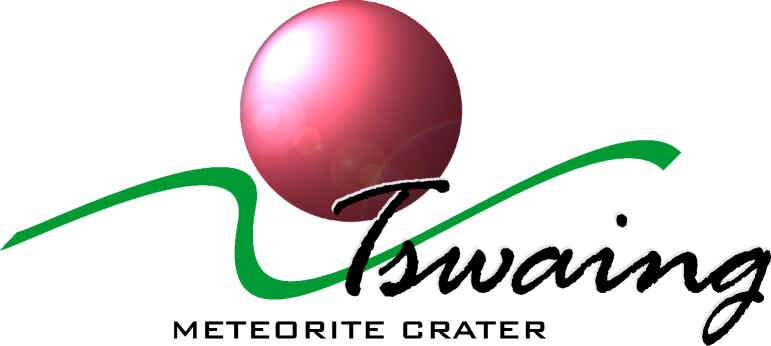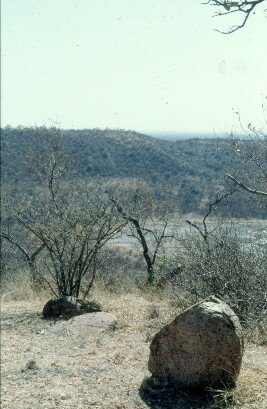|
Granite block ejected onto rim during cratering event (courtesy National Cultural History Museum) |
 |
|
Geology And Minerals |
|
| The bowl-shaped Tswaing Crater is located in the southern portion of the 2 050-million year old Bushveld Complex, at a latitude 25º24'30" S and longitude 28º04'59" E. The Bushveld Complex is very important in its own right. It is a geologically unique magmatic structure, stretching from Pretoria in the southwest to Phalaborwa in the northeast, and from Middelburg in the south to Potgietersrus in the north. It contains a fill of several kilometres of magmatic rocks that form a sequence of near-horizontally-layered rock types. It hosts some of the world's most important ore reserves, including much of the world's chromium, vanadium and platinum. In addition, tin and silver have been mined from the granite rocks of the Bushveld Complex, and large dimension-stone quarries are active in this area. The near-circular Tswaing Crater has a 1,13-kilometre (from rim to rim) diameter. The rim is well preserved and consists of granite fragments, which are generally angular and may reach more than a metre in length. The rim is elevated by 60 metres above the surrounding plains, and the maximum elevation of the rim above the crater floor is 119 metres. The excellent preservation of the rim indicates a young age for the crater: if the crater had been older, the blocks of granite still evident on the crater rim, which were thrown out of the interior when the crater formed, would long have been eroded. The crater and the surrounding area consist predominantly of the pinkish Nebo Granite, which is the main granite type of the Bushveld Complex. Large parts of the surrounding countryside are covered by coarse sands and grits derived from recent weathering of the underlying Nebo Granite. Other areas are covered by sedimentary rocks (sandstones, shales and grits) belonging to the 300 to 190-million year old Karoo Supergroup, or by recent alluvium. Granite, the most common rock type at the crater and in the surrounding region, is found on the higher areas of the inner and outer rims of the crater. In hand specimen, the fresh granite appears as a coarse-grained, pink rock. The largest grains, which are pink or light brown, consist of the mineral K-feldspar and are interlocked with large quartz grains of milky white or light-grey appearance. Minor amounts of the minerals hornblende and biotite appear as dark specks. Highly altered granite is also common in the crater and is particularly abundant in parts of the crater rim. It is recognised by its typical whitish to greyish colour. The weathering of rock of parts of the crater rim is the result of surface waters penetrating the granite along fractures and joint planes. The fractures, which are very common in the granite rim, allow easy access for the surface water. The granite weathers into large, rounded boulders or into smaller, angular, crumbly fragments of feldspar and quartz. The mud, occupying the floor of the crater, is partly the product of the decomposition of the granite. Intrusive magmatic rocks are present in many places along the crater rim and are particularly evident in the northern sector of the rim, with only a few occurrences elsewhere. These igneous rocks include lamprophyre, trachyte, phonolite and carbonatite. Most of these intrusions are fairly weathered and typically fractured. They occur in the form of thin dykes or sills. They are often fractured and displaced by small faults, presumably as a consequence of the cratering event. These intrusive rocks are some 1 300 million years old, much older than the cratering event. The youngest rocks occurring at Tswaing area are sedimentary rocks of the Karoo Supergroup. This group of rocks includes shale, sandstone and a gritty sediment, known as Karoo Grits. Only the latter occur close to the crater. These rocks, which are some 220 million years old, are believed to have partly covered the granite in the crater region at the time of the cratering event. |
|
| (Source: REIMOLD, W U, BRANDT, D, DE JONG, R C, HANCOX, J, 1999, Tswaing Meteorite Crater. An introduction to the natural and cultural history of the Tswaing region including a description of the hiking trail. Popular Geoscience Series 1. Pretoria: Council for Geoscience. Available at the Council for Geoscience, Pretoria, South Africa) | |
| All intellectual property rights, including but not limited to copyright and trademarks, vested in the material contained on the NFI website is held by the NFI and may not be copied, reproduced, adapted, published or distributed in any form whatsoever without the prior written consent of the responsible person at the NFI. | |
